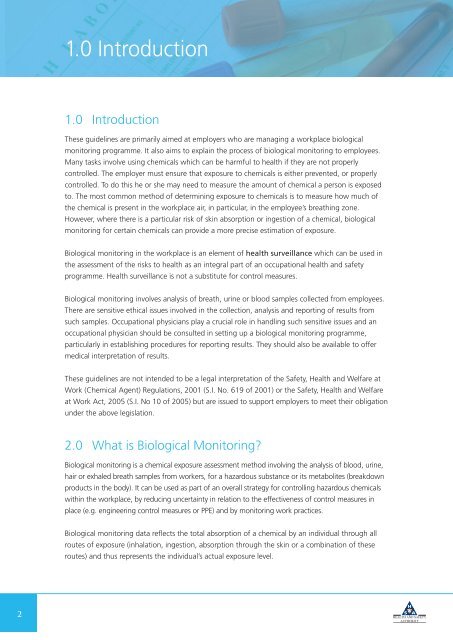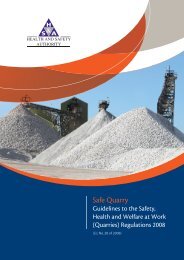Biological Monitoring Guidelines - Health and Safety Authority
Biological Monitoring Guidelines - Health and Safety Authority
Biological Monitoring Guidelines - Health and Safety Authority
Create successful ePaper yourself
Turn your PDF publications into a flip-book with our unique Google optimized e-Paper software.
1.0 Introduction<br />
1.0 Introduction<br />
These guidelines are primarily aimed at employers who are managing a workplace biological<br />
monitoring programme. It also aims to explain the process of biological monitoring to employees.<br />
Many tasks involve using chemicals which can be harmful to health if they are not properly<br />
controlled. The employer must ensure that exposure to chemicals is either prevented, or properly<br />
controlled. To do this he or she may need to measure the amount of chemical a person is exposed<br />
to. The most common method of determining exposure to chemicals is to measure how much of<br />
the chemical is present in the workplace air, in particular, in the employee’s breathing zone.<br />
However, where there is a particular risk of skin absorption or ingestion of a chemical, biological<br />
monitoring for certain chemicals can provide a more precise estimation of exposure.<br />
<strong>Biological</strong> monitoring in the workplace is an element of health surveillance which can be used in<br />
the assessment of the risks to health as an integral part of an occupational health <strong>and</strong> safety<br />
programme. <strong>Health</strong> surveillance is not a substitute for control measures.<br />
<strong>Biological</strong> monitoring involves analysis of breath, urine or blood samples collected from employees.<br />
There are sensitive ethical issues involved in the collection, analysis <strong>and</strong> reporting of results from<br />
such samples. Occupational physicians play a crucial role in h<strong>and</strong>ling such sensitive issues <strong>and</strong> an<br />
occupational physician should be consulted in setting up a biological monitoring programme,<br />
particularly in establishing procedures for reporting results. They should also be available to offer<br />
medical interpretation of results.<br />
These guidelines are not intended to be a legal interpretation of the <strong>Safety</strong>, <strong>Health</strong> <strong>and</strong> Welfare at<br />
Work (Chemical Agent) Regulations, 2001 (S.I. No. 619 of 2001) or the <strong>Safety</strong>, <strong>Health</strong> <strong>and</strong> Welfare<br />
at Work Act, 2005 (S.I. No 10 of 2005) but are issued to support employers to meet their obligation<br />
under the above legislation.<br />
2.0 What is <strong>Biological</strong> <strong>Monitoring</strong>?<br />
<strong>Biological</strong> monitoring is a chemical exposure assessment method involving the analysis of blood, urine,<br />
hair or exhaled breath samples from workers, for a hazardous substance or its metabolites (breakdown<br />
products in the body). It can be used as part of an overall strategy for controlling hazardous chemicals<br />
within the workplace, by reducing uncertainty in relation to the effectiveness of control measures in<br />
place (e.g. engineering control measures or PPE) <strong>and</strong> by monitoring work practices.<br />
<strong>Biological</strong> monitoring data reflects the total absorption of a chemical by an individual through all<br />
routes of exposure (inhalation, ingestion, absorption through the skin or a combination of these<br />
routes) <strong>and</strong> thus represents the individual’s actual exposure level.<br />
2
















